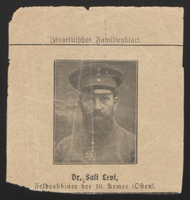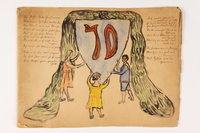Overview
- Brief Narrative
- Oak leaf wreath with acorns, now in several pieces, awarded to Max Eis in the mid-1930’s for swimming across the Rhine River near the town of Mainz, Germany, where he lived with his parents, Jakob and Regina, and his brother, Albert. Max and Alfred participated in athletic competitions as members of the Mainz chapter of the Jewish sports club, Schild, which was associated with Reichsbund Juedischer Frontsoldaten (The Organization of Jewish Front-line Soldiers), an organization founded by Jewish veterans in 1919 to counter anti-Semitic accusations that Jewish soldiers had been weak and cowardly during World War I. In January 1933, Hitler was appointed Chancellor of Germany and many laws were enacted to restrict the lives of Jews. On August 16, 1938, 21 year old Max left Mainz for London, where, on September 2, he boarded a ship to the United States. In March 1939, Max helped Albert, 36, immigrate to the US. In September 1942, Max’s parents were deported to Theresienstadt labor camp-ghetto in German occupied Czechoslovakia, where Regina died in March 1943. Jakob was liberated at the camp May 1945 by Soviet forces. He joined his sons in the US in May 1946.
- Date
-
received:
1933-approximately 1937
- Geography
-
received:
Mainz (Germany : Landkreis)
- Credit Line
- United States Holocaust Memorial Museum Collection, Gift of Regina Lackner
- Contributor
-
Subject:
Max Eis
- Biography
-
Max Eis was born on January 1, 1917, in Mainz, Germany, to Jewish parents Jakob and Regina Meyer Eis. Jakob Eis was born on December 20, 1877, in Bingen, Germany. Regina Meyer was born on September 26, 1875, in Reichelsheim, Germany. She had one older brother, Gustav, who was born in 1874, and immigrated to the United States, where he settled in New Jersey. On July 30, 1902, Jakob and Regina married, and they settled in Mainz, where Jakob worker as a cooper and vintner. Their first son, Alfred, was born on September 26, 1903. Max was a talented swimmer, while Albert excelled at track and field. Both participated in athletic competitions held by local sports clubs and associations in Mainz.
On January 30, 1933, Adolf Hitler was appointed Chancellor of Germany. Anti-Jewish decrees were passed that restricted every aspect of Jewish life. In April, Max graduated from high school and became an apprentice at the Maweli A.G. Distillery in Mainz. In the mid-1930’s, Jews were not welcome in non-Jewish sports clubs or associations, so Max and Albert both joined the Jewish sports club, Schild, which was associated with Reichsbund Juedischer Frontsoldaten (The Organization of Jewish Front-line Soldiers) in order to continue competing in sporting events. Conditions worsened for Jews in Germany as more punitive anti-Jewish laws were enacted. The family began to make plans to leave Germany. In January 1936, Max’s uncle Gustav Meyer filed sponsorship papers with the US government stating that he was willing and able to support Max if he was allowed to immigrate to the United States.
On August 16, 1938, Jakob took Max to the train station in Mainz, but Regina was too sick to go with them. Max boarded a train to Belgium and then continued on to London, England. A woman named Mrs. Michaels and her son took him to Woburn House, a shelter in London’s east end, where many Jewish German refugees were staying. After several days, Max left for Liverpool. He was given 10 pounds, which was more money than he had been allowed to take out of Germany. On September 2, Max boarded the S.S. Roosevelt and sailed for New York City. Max settled in Newark, New Jersey, near his uncle, and found work as a clerk at a wine and liquor wholesaler. On November 9 or 10, during the Kristallnacht pogrom, Max’s brother Albert was attacked in Mainz. In March 1939, Max helped Albert immigrate to the US. He joined Max in New Jersey and worked for a wine and liquor wholesaler.
On September 1, 1939, Germany invaded Poland and World War II began. On April 14, 1940, Albert married Irma Edinger. Irma was born on May 15, 1905, in Mainz, to Sali and Amalia Rosenthal Edinger. She was trained as a nurse in Germany, and immigrated to the United States in July 1937. On January 4, 1942, Max married Ruth Levi, who was born in approximately 1920, in Mainz, to Dr. Rabbi Sali and Margarete Weissman Levi. Max, Albert, and Irma made deposits with the transmigration bureau to get Jacob and Regina out of Germany, but their efforts were unsuccessful. On September 27, 1942, Jakob and Regina were deported from Mainz to Theresienstadt labor camp-ghetto in German occupied Czechoslovakia. Regina, age 68, died on March 28, 1943, in Theresienstadt.
In February 1945, Max sent Jakob a Red Cross letter announcing that his first grandchild had been born. On May 2, 1945, the International Red Cross took over Theresienstadt. Germany surrendered on May 7, 1945, and Theresienstadt was officially liberated by the Soviet Army on May 9. By April 1946, Jakob had been in both Deggendorf and Funk Kaserne displaced persons camps in Bavaria, Germany. Irma booked passage for Jakob on the S.S. Marine Perch, and on May 13, 1946, he sailed for New York City. Jakob, age 74, died on April 14, 1952, in New York City. In the mid-1950’s, Max, Ruth, and their two children, along with Albert and Irma, moved to Oakland, California, where Max opened his own dairy company. Irma, age 68, died on December 4, 1973, in Oakland, California. Albert, age 83, died on January 22, 1987. Max, age 74, died on November 11, 1991, in Oakland.
Physical Details
- Classification
-
Dress Accessories
- Category
-
Headgear
- Object Type
-
Wreaths (costume accessories) (aat)
- Physical Description
- a. Oak leaf wreath consisting of 3 green paper wrapped wire ovals: 2 tied together at one end (a) and 1 detached oval (b.) The coated brown, dark green, and red leaves are tied onto both ovals with brown paper wrapped wire stems. Imitation acorns, made of cotton batting covered in a thin green painted plastic coating, are glued into natural brown acorn caps and attached to both ovals by wire stems. A discolored, half red, half white ribbon is tied in a bow on top of each oval. The wreath has several bent leaves and cracked acorns.
b. Part of an oak leaf wreath (a) consisting of 1 green paper wrapped wire oval. The coated brown, dark green, and red leaves are tied onto one end of the oval with brown paper wrapped wire stems. Several wire stems without leaves are tied to the other end. Imitation acorns, made of cotton batting covered in a thin green painted plastic coating, are glued into natural brown acorn caps and attached to the oval by wire stems. A discolored, half red, half white ribbon is tied in a bow on top of the oval. The oval has several bent leaves and cracked acorns.
c. Several coated dark green and brown oak leaves and fragments detached from wreath (a and b.)
d. Two imitation acorns detached from wreath (a and b), made of cotton batting and covered in a thin light green painted plastic coating with flecks of iridescent gold-colored paint. They are glued into natural acorn caps, also painted gold.
e. Fragments of natural brown acorn caps, with traces of adhesive, detached from wreath (a and b.) - Dimensions
- a: Height: 10.750 inches (27.305 cm) | Width: 8.500 inches (21.59 cm) | Depth: 1.000 inches (2.54 cm)
b: Height: 10.000 inches (25.4 cm) | Width: 9.125 inches (23.178 cm) | Depth: 0.500 inches (1.27 cm) - Materials
- a : leaf, stem, metal, paper, paint, adhesive, ribbon, cotton, plastic
b : leaf, stem, metal, paper, paint, adhesive, ribbon, cotton, plastic
c : leaf
d : stem, paint, adhesive, cotton, plastic
e : stem, adhesive
Rights & Restrictions
- Conditions on Access
- No restrictions on access
- Conditions on Use
- No restrictions on use
Keywords & Subjects
Administrative Notes
- Legal Status
- Permanent Collection
- Provenance
- The wreath was donated to the United States Holocaust Memorial Museum in 2012 by Regina Lackner, the daughter of Max Eis.
- Funding Note
- The cataloging of this artifact has been supported by a grant from the Conference on Jewish Material Claims Against Germany.
- Record last modified:
- 2022-07-28 20:14:02
- This page:
- https://collections.ushmm.org/search/catalog/irn61051
Download & Licensing
In-Person Research
- By Appointment
- Request 21 Days in Advance of Visit
- Plan a Research Visit
- Request to See This Object
Contact Us
Also in Max and Ruth Levi Eis family and the Kronthal family collection
The collection consists of a wreath, correspondence, documents, photographs, and publications relating to the experiences of Max Eis and his family in Mainz, Germany, before the Holocaust, in Theresienstadt labor camp-ghetto during the Holocaust, and after their respective immigrations to the United States and also to the experiences of the Levi and Kronthal families in Mainz and Breslau, Germany, before the Holocaust, in several concentration camps during the Holocaust, and after their respective immigrations to the United States.
Date: 1867-2010

Levi, Kronthal, and Eis families papers
Document
The Levi, Kronthal, and Eis family papers document the family of Sali Levi, last rabbi of the old Jewish community of Mainz, as well as the families of his wife Margarete Levi, nee Weissmann, his sister-in-law Rosa Kronthal, his son Hans Levi, and his son-in-law Max Eis. The collection contains biographical materials, correspondence, subject files, photographs, sermons, writings, speeches, and books documenting the lives of the Kronthal, Levi, and Eis families as they were forced to flee Germany and immigrate to the United States during the Holocaust. Biographical materials date from 1867-circa 2010 and include birth, marriage, and death certificates; identification and membership cards; school records; awards; military papers; engagement and marriage announcements; immigration and naturalization records; employment records; wills; death notices and obituaries; mourning books; personal and family histories; vaccination records; and clippings. Correspondence files date from 1918-1997 and include letters among family members, friends, and professional and social contacts. Subjects include Kristallnacht, immigration efforts, and life in Germany, Theresienstadt, Deggendorf, and America. The files include Hans Levi’s objections to the American Consul in Switzerland’s lack of attention to Rosa Kronthal’s immigration efforts, photocopies of Sali Levi’s 1933 objections to the way his son’s high school was treating Jewish students as “guests,” correspondence between Albert Eis and the wife of the man who assaulted him during Kristallnacht, and letters of thanks and praise for Rosa Kronthal from Eleanor Roosevelt, Leo Baeck, and Joachim Prinz. Subject files date from 1934-2010 and include information about the families’ immigration efforts, the Jüdische Bezirksschule Mainz, the Jüdische Selbstverwaltung Theresienstadt, Walldorf, and restitution claims pursued by various family members for confiscated goods, taxes and fees, bank accounts, pensions, insurance policies, and lost income. Photographs date from 1911-2000 and include family members; the synagogue, Jewish museum, and Jüdische Bezirksschule in Mainz; Rosa Kronthal's and Sali Levi's gravestones; Wilhelm and Johanna Levi's house; and photographs related to one of Max Eis' employers. Sali Levi’s writings and speeches date from circa 1906-1941 and cover religious topics and personal experiences. They include eulogies and descriptions of old Jewish gravestones in Mainz, Jews in Russian Poland, and prayer books used by soldiers in the field during World War I. Sali Levi’s sermons date from 1908-1941 and are accompanied by computer disks and printed draft English transcriptions of some of the sermons. Books in the collection date from 1880-1994 and include religious and prayer books owned by Sali Levi, works on the Holocaust and Jewish communities in Germany, a prayer book belonging to Jakob Eis, and a book of sermons by Seligmann Meyer.




